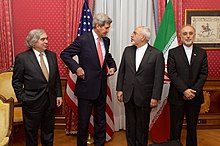Ali Akbar Salehi
Ali Akbar Salehi | |
|---|---|
Minister of Foreign Affairs of Iran | |
| In office 30 January 2011 – 15 August 2013 Acting: 13 December 2010 – 30 January 2011 | |
| President | Mahmoud Ahmadinejad |
| Preceded by | Manouchehr Mottaki |
| Succeeded by | Mohammad Javad Zarif |
| Personal details | |
| Born | 24 March 1949 Karbala, Iraq |
| Nationality | Iranian |
| Spouse | Zahra Rada[1] |
| Children | 3[2] |
| Awards |
|
| Signature |  |
| Academic background and work | |
| Fields | Nuclear engineering Nuclear physics |
| Alma mater | American University of Beirut Massachusetts Institute of Technology |
| Thesis | Resonance Region Neutronics of Unit Cells in Fast and Thermal Reactors (1977) |
| Doctoral advisor | Michael J. Driscoll |
| Institutions | Sharif University of Technology Imam Khomeini International University |
Ali Akbar Salehi (
Early life and education
Salehi was born in
Career

Salehi is full professor and was

An ISIS (Institute for Science and International Security) report claims the Physics Research Center acted as a front in the late 1980s and early 1990s to obtain illicit nuclear technologies. ISIS claims that, as head of Sharif University, Salehi was aware of purchases.[13]
Salehi was appointed as permanent representative of Iran to the International Atomic Energy Agency by the then president Mohammad Khatami on 13 March 1997 and remained in the post until 22 August 2005. On 18 December 2003, Salehi signed the Additional Protocol to the safeguard agreement, on behalf of Iran. He was replaced by Pirooz Hosseini.
Salehi was deputy secretary-general of the Organisation of the Islamic Conference under Ekmeleddin İhsanoğlu from 2007 to 2009. He resigned on 16 July 2009 when then President Mahmoud Ahmadinejad appointed Salehi as the new head of Iran's Atomic Energy Organization, replacing Gholam Reza Aghazadeh who resigned on 10 July. Salehi resigned from office on 23 January 2011 when Ahmadinejad nominated him as foreign minister.
On 13 December 2010, Ahmadinejad dismissed
Sanctions
As the head of the AEOI when Iran was facing increased scrutiny in light of International Atomic Energy Agency findings, Salehi was designated for financial sanctions and travel restrictions by the European Union and the United Kingdom.[16][20] Salehi and Ernest Moniz joined 2015 Geneva Iran and P5+1 nuclear talks to discuss more about technical aspects of Iran nuclear program.[21] Salehi has been selected among the ten people who mattered the year 2015 by Nature magazine because of his role in nuclear talks.[22] As the head of the AEOI, Salehi also was designated for secondary sanctions imposed by the United States Department of the Treasury.[23]
See also
References
- ^ همسر علیاکبر صالحی در اردن +عکس
- ^ گفت و گوی دوستانه با علی اکبر صالحی
- ^ "Iran's FM, nuclear chief, DM receive medals for role in nuclear deal". Iranian Students' News Agency. 8 February 2016. Archived from the original on 31 May 2016. Retrieved 15 April 2016.
- ^ نشانهای دولتی در روزهای پایانی خاتمی و احمدینژاد به چهکسانی رسید؟. Tasnim News Agency (in Persian). 24 August 2013. Retrieved 15 April 2016.
- ^ "The Salehi Memoirs: Diplomat, Scientist, Negotiator".
- ^ Boroujerdi, Mehrzhad (31 January 2011). "Iran's New Foreign Minister: Ali Akbar Salehi". PBS. Retrieved 15 May 2012.
- ^ a b Kambiz Tavana; Arash Karami (1 December 2011). "The Man to Watch in Iran?". PBS. Retrieved 10 February 2013.
- ^ a b "President appoints Salehi as Nuclear Energy Organization Chief". IRNA. 15 August 2013. Archived from the original on 2 March 2014. Retrieved 16 August 2013.
- hdl:1721.1/16333.
- ^ "Q/A with David Albright: Iran should come clean about past research | the Back Channel". Archived from the original on 2 March 2014. Retrieved 30 September 2013.
- ^ Elsevier SCIENTIA IRANICA Archived 3 November 2012 at the Wayback Machine Retrieved 11 February 2013.
- ^ "US nuclear expert: Iranian FM Salehi linked to past program". The Jerusalem Post. 16 May 2012. Retrieved 15 May 2012.
- ^ Zakaria, Tabassum (15 May 2012). "U.S. nuclear expert: Iran official linked to past program". Reuters. Retrieved 15 May 2012.
- ^ Theodoulou, Michael (14 December 2010). "Ahmadinejad fires foreign minister on overseas trip". The National. Retrieved 21 January 2013.
- ^ "Parliament Okays Salehi as Iran's New Foreign Minister". Fars News. 30 January 2011. Archived from the original on 14 March 2012. Retrieved 21 January 2013.
- ^ a b "Asset Freeze Targets" (PDF). HM Treasury. Retrieved 21 January 2013.
- ^ Ben Weinthal (6 July 2012)."Cyprus detains Iran FM due to old sanctions" The Jerusalem Post. Retrieved 11 February 2013.
- ^ a b Khalaj, Monavar (15 August 2013). "Iran parliament approves new president's cabinet nominees". Financial Times. Tehran. Retrieved 15 August 2013.
- ^ "Iran Parliament approves big Rouhani cabinet nominees, rejects 3". Hurriyet. Dubai. Reuters. 16 August 2013. Retrieved 17 August 2013.
- ^ Iranian FM, a driving force behind the nuclear program, visits New York Archived 9 March 2012 at the Wayback Machine, Realite, 20 September 2011
- ^ "Iran sends high-level negotiators to Geneva nuclear talks". Reuters. 21 February 2015. Retrieved 21 February 2015.
- ^ "365 days: Nature's 10 Ten people who mattered this year". Nature. 17 December 2015.
- ^ "Iran-related Designation and Designation Update; Non-proliferation Designation and Designation Update". U.S. Department of the Treasury. Retrieved 30 January 2020.
